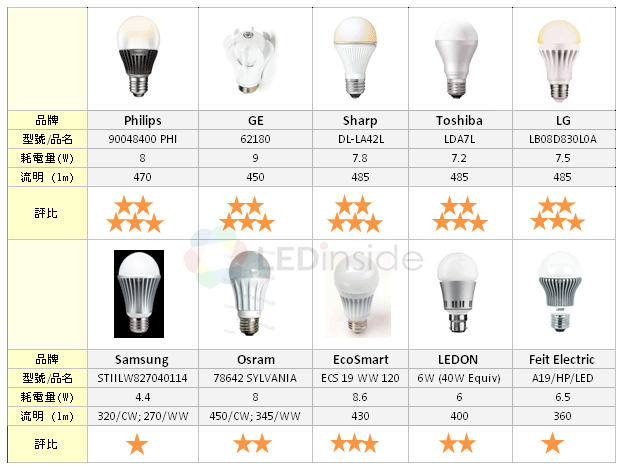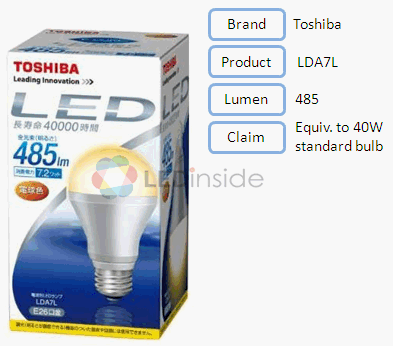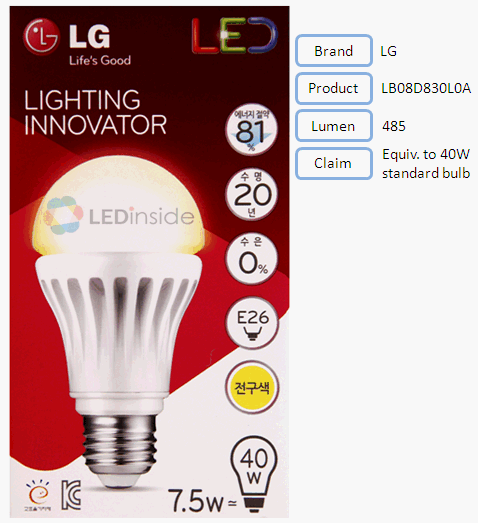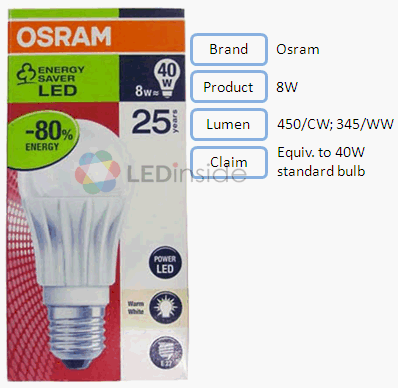LEDinside: Luminous Flux is Key to LED Light Bulbs’ Replacement of 40W Incandescent Light Bulbs
Currently descriptions of many LED light bulbs on the market indicate that they are able to replace the 40W incandescent light bulbs, but are they really able to replace incandescent light bulbs in terms of luminous flux? Based on the comparative survey of LEDinside, luminous flux is a key factor.
The luminous efficacy of traditional light sources like incandescent bulbs is approximately 11-12 l/W. In other words, to truly replace a 40W incandescent light bulb, the luminous flux ought to reach at least 450lm.
LEDinside: Initial Luminous Flux Survey of Major LED Brands in 1H11
According to the comparative survey conducted by LEDinside, some vendors’ LED light bulbs indeed reach 450lm, but some vendors’ regrettably do not.

As we know, the luminous efficacy of traditional light sources like incandescent bulbs is approximately 11-12 l/W. In other words, one 40W incandescent bulb should have a luminosity of at least 450lm. In areas such as United States, Europe and Japan, the substitution of traditional light sources with LED illumination must meet certain requirements, one of which that the luminosity of LED bulbs has to be between 450 and 485lm. Therefore, a survey of LED bulbs currently on the market reveals unsurprisingly that advertisements for many products state that they can replace traditional 40W bulbs. However, closer inspection of product specifications reveals that recognized standards are not uniform, as products with luminosities ranging from 485-340lm can be found. Some manufacturers believe that due to the directivity of LED luminous flux, in certain situations, for instance in desk lamps with limited illumination radius, LED bulbs rated at 300 or so lm are acceptable replacements for 40W incandescent bulbs.
The luminosity requirements for LED bulbs replacing 40W incandescent bulbs vary significantly among different brands and products. Therefore, LEDinside surveyed the luminosity specifications of representative LED bulb manufacturers worldwide, with the following findings:
For European and American lighting manufacturers like Philips and GE, Philips’ 8W Master LEDbulb and GE’s 8W Model No. 62180 LED bulb met this requirement with luminous flux of 470 lm and 450 lm, respectively.


For Japanese manufacturers, known for their diligence and meticulous work, both Toshiba’s 7.2W LDA7L and Sharp’s 7.8W DL-LA42L met the 485 lm standard, complying with Japan Electric Lamp Manufacturers Association’s guideline specifications.


For LG, its 7.5W LED bulb (model no. LB08D830L0A) also met this lm standard. However, the shocker was Samsung. Its 4.4W product only had a luminosity of 270 lm and 320 lm for warm white and cool white, respectively. Such discrepancy was unexpected.
Note: Samsung states that aside from its light bulbs in the South Korean market, it also lanuches new light bulbs in the American market: Samsung Launches New 10W Light Bulb with 3000K and 550lm


Furthermore, other manufacturers like EcoSmart, LEDON, and Feit Electric have also introduced LED bulbs to replace 40W incandescent bulbs, including EcoSmart’s 8.6W LED bulb (model: ECS 19 WW 120), LEDON’s 6W products, and Feit Electric’s 6.5W LED bulb (A19/HP/LED). However, the survey showed that the luminous flux of these products did not hit the 450 lm mark, either.



Finally, Osram is in an interesting position, as its cold white LED light bulb reached 450lm while its warm white only had 345lm.If Osram is able to develop white light LED with a luminous flux as high as 450, it should manage to narrow the current luminosity gap (115lm) between warm white light and cold white light products.

Perspectives from LEDinside
In light of the vast standard deviation among different manufacturer’s products, LEDinside points out that the choice of LED light bulbs for the sake of energy saving should base on not only whether it is an adequate replacement for 40W incandescent light bulb but also its luminous flux.





 CN
TW
EN
CN
TW
EN















